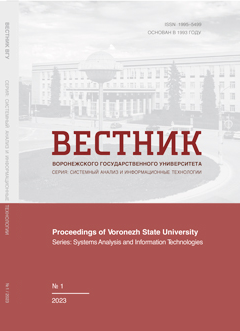Обзор основных классов операторов порядкового взвешенного агрегирования
Аннотация
В статье рассматриваются основные классы операций порядкового взвешенного агрегирования, которые получили широкое распространение из-за наличия ряда числовых характеристик, обеспечивающих целенаправленный подход к организации процедуры агрегирования информации в системах мониторинга, информационно-аналитических системах, в экспертных системах и системах поддержки принятия решений, в нечетких системах и других, в которых осуществляется обработка информации в рамках оценочных моделей. Особенностью данного типа операторов является то, что векторная оценка объекта перед агрегированием упорядочивается по невозрастанию или по неубыванию, что позволяет непосредственно учитывать значения компонент, а не важность источников информации, как это делается при использовании взвешенных средних. Моделирование операций агрегирования данного класса сводится к разработке подходов для определения весовых коэффициентов. Назначая определенным образом веса, можно спроектировать процедуру агрегирования с определенными свойствами, в частности, стратегией, компенсационными свойствами, уровнем равномерности учета компонентов векторной оценки. В статье рассматриваются различные семейства операций, реализующих технологию порядкового взвешенного агрегирования, их обобщения и модификации, а также важные случаи. Показана связь данных операторов с интегралами Сугено и Шоке, а также приведены обобщенные представления на основе нечетких мер. Представленный обзор зарубежных публикаций открывает возможности для широкого использования операций агрегирования из данного класса при разработке процедур обработки информации в различных прикладных системах, позволяя обеспечить большую гибкость, многоальтернативность, обоснованность и интерпретируемость.
Скачивания
Литература
2. Dzhini K. (1970) Sredniye velichiny. Moskva : Statistika (in Russian).
3. Beliakov G., Bustince H. and Calvo T. (2016) Practical Guide to Averaging Functions. Springer. DOI
4. Ledeneva T. M. and Podval’ny S. L. (2016) Agregirovaniye informatsii v otsenochnykh modelyakh. Vestnik VGU. Seriya: Sistemnyy analiz i informatsionnyye tekhnologii. (4). P. 155–164. (in Russian)
5. Grabisch M., Marichal J.-L., Mesiar R. and Pap E. (2011) Aggregation functions: Means. Information Science. (181). P. 1–22.
6. Saati T. (1993) Prinyatiye resheniy. Metod analiza iyerarkhiy. Мoskva : Radio i svyaz. (in Russian)
7. Belkin A. M. and Levin M. SH. (1990) Prinyatiye resheniye: kombinatornyye modeli approksimatsii informatsii. Moskva : Nauka. (in Russian)
8. Detyniecki M. and Bouchon-Meunier B. (2000) Building an aggregation operator with a balance in IPMU, July 2000, Madrid, Spain. P. 686–692.
9. Detyniecki M. and Bouchon-Meunier B. (2000) Aggregation truth and falsity values in FUSION’2000, July 2000, Paris, France. P. 18–24.
10. Yager R. R. (1994) Aggregation operators and fuzzy modeling. Fuzzy Sets and Systems. (67). P. 129–145.
11. Zimmermann H.-J. (1993) Fuzzy Technologien: prinzipien, werkzeuge, potentiale. Duesseldorf.
12. Herrera H., Herrera-Viedma E. and Verdegay J. L. (1996). Direct approach processes in group decision making using linguistic OWA operators. Fuzzy Sets and Systems. (79). P. 175–190.
13. Klement E. P., Mesiar R. and Pap E. (2004) Triangular norms. Position paper II: general constructions and parameterized families. Fuzzy Sets and Systems. (145). P. 439–454.
14. Khameneh A. Z. and Kilicman A. (2020) Some construction methods of aggregation operators in decision-making problems: an overview. Symmetry. (12). P. 694. DOI
15. Mesiar R. (1995) Compensatory operators based on triangular norms and conforms in Proc. EUFIT, Aachen, 1995. P. 131–135.
16. Ledeneva T. M. (2018) Analysis of additive generators of fuzzy operations represented by rational functions. Journal of Physics: Conf. Series. 973 (012037). DOI
17. Zhao H., Xu Z. S., Ni M. F. and Lui S. S. (2010) Generalized aggregation operators for intuitionistic fuzzy sets. International Journal of Intelligent Systems and Applications. (25). P. 1–30.
18. Zhang G., Zhang Z. and Kong Zhang H. (2018) Some normal intuitionistic fuzzy heronian mean operators using Hamacher Operation and their applications. Symmetry (10). P 199.
19. Wang W. Z. and Liu X. W. (2011) Intuitionistic fuzzy geometric aggregation operators based on Einstein operations. International Journal Intelligent Systems. (26). P. 1049–1075.
20. Komornikova M. and Mesiar R. (2011) Aggregation functions on bounded partially ordered sets and their classifications. Fuzzy Sets and Systems. 175(1). P. 48–56.
21. Yager R. R. (1993) Families of OWA operators. Fuzzy Sets and Systems. (59). P. 125–148.
22. Martinez D.L.L.R. and Acosta J. C. (2015) Aggregation operators review – Mathematical properties and behavioral measures. International Journal of Intelligent Systems and Applications. (7). P 63–76.
23. Grabisch M., Marichal J., Mesiar R. and& Pap E. (2009) Aggregation Functions. Cambridge : Cambridge University Press. DOI
24. Calvo T. and Mesiar R. (2001) Generalized medians. Fuzzy Sets and Systems. (124). P. 59–64.
25. Dubois D. and Prade H. (1986) Weighted minimum and maximum operations in fuzzy set theory, in Hollnagel, E. (ed) The Reliability of Expert Systems. Chichester : Ellis Horwood Limited. P. 64–118.
26. Yager R. R. and Kacprzyk J. (1997) The ordered weighted averaging operators: theory and applications. Boston, Dordrecht, London : Kluwer Academic Publisher.
27. Larsen H. L. (2002) Construction of OWA operators with desired properties. Fuzzy Sets and Systems. (94). P. 167–183.
28. Ledeneva Т. М. and Tafintseva M. V. (2006) Modelirovaniye svoystv poryadkovykh operatorov vzveshennogo agregirovaniya. Vestnik Voronezhskogo gosudarstvennogo universiteta. Seriya: Fizika. Matematika. (1). P. 66–72.
29. Renyi A. (1961) On measures of entropy and information. Proc. 4th Berkley Symp. on Mathematical Statistics and Probability. California : University of California Press. Vol. 1. P. 747–561.
30. Fuller R. and Majlender R. (2003) On obtaining minimal variability OWA operator weights. Fuzzy Sets and Systems. (136). P. 203–215.
31. Jin L., Kalina M. and Gang Q. (2015) Fuzzy orness measure and new orness axioms. Kybernetika. 51(4). P. 712–723. DOI
32. Yager R. R. (1996) Quantifier guided aggregation using OWA operators. International Journal of Intelligent Systems. (11). P. 49–73.
33. Zeshui Xu (2005) An overview of methods for determining OWA weights: Research Articles. International Journal Intelligent Systems. 20(8). P. 843–865.
34. Matveev M., Aleynikova N., Safonov V. and Korobova L. (2022) The study of fuzzy quantifiers in multi-criteria decision-making. Communications in Computer and Information Science. 1539 CCIS. P. 167–179.
35. Amin G. R. and Emrouznejad Ali. (2011) Parametric aggregation in ordered weighted averaging. International Journal Approximation Reasoning. 52 (6). P. 819–827.
36. Zarghami M. and Szidarovszky F. (2009) Revising the OWA operator for multi criteria decision making problem under uncertainty. European Joupnal of Operational Research. (198). P. 259–265.
37. Garcia-Zamora D., Labello A., Rodriguez R. M. and Martinez L. (2021) An ordered weighted averaging operator based on extreme values reductions. Atlantis Studies in Uncertainty Modelling. (3). P. 290–297.
38. Kolesarova A., Mesiar R. and Ruckschlossova T. (2014) Power stable aggregation functions. Fuzzy Sets and Systems. (240). P. 39–50.
39. O’Hagan M. (1988) Aggregating template or rule antecedents in real-time expert systems with fuzzy sets logic in 22 Asilomar Conference on Signals, Systems and Computers. P. 681–689.
40. Majlender P. (2005) OWA-operators with maximal Renyi entropy. Fussy sets and systems. (155). P. 340–360.
41. Fishburn P. C. (1965) Analysis of decisions with incomplete knowledge of probabilities. Operations Research. 3(1). P. 217–237.
42. Sigal А. V. (2021) Ispol’zovaniye posledovatel’nostey Fishberna dlya adekvatnogo modelirovaniya po vyborochnym dannym. Biznes-informatika. 15(4). P. 50–56.
43. Klement E. P., Mesiar R. and Pap E. (2004) Measure-based aggregation operators. Fuzzy Sets and Systems. (142). P. 3–14.
44. Llamazares B. (2015) Constructing Choquet integral-based operators that generalize weighted means and OWA operators. Information Fusion. (23). P. 131–138.
45. Smolikova R. and Wachowiak M. P. (2002) Aggregation operators for selection problems. Fuzzy Sets and Systems. (131). P. 23–34.
46. Matveev М. G. (2021) Informatsionnyye tekhnologii formirovaniya predlozheniy na elektronnoy torgovoy ploshchadke s tekhnologiyey marketpleys. Ekonomika i matematicheskiye metody. 57(1). P. 105–112.
47. Llamazares, B. (2018) Construction of Choquet integrals through unimodal weighting vectors. International Journal Intelligent Systems. 20(8). P. 771–790.
48. Yager R. R. (2019) OWA aggregation with an uncertainty over the arguments. Information Fusion. (52). P. 206–212. DOI
49. Mesiar R., Stupnanova A. and Jin L. (2021) Bipolar ordered weighted averages: BIOWA operators. Fuzzy sets and Systems (in press). DOI
50. Chiclana F., Herrera-Viedma E., Herrera F. and Alonso S. (2004) Induced ordered weighted geometric operators and use in the aggregation of multiplicative preference relations. International Journal of Intelligent Systems. (19). P. 233–255.
51. Ledeneva T. (2020) Special Aspects of the Design of Fuzzy Inference Mechanism in 2nd International Conference on Control Systems, Mathematical Modeling, Automation and Energy Efficiency (SUMMA). P. 128–132. DOI
52. Mayor G. and Calvo T. (1997) On extend ed aggregation functions in Proc. IESA, Prague. P. 281–285.
53. Mas M., Mayor G., Suner J. and Torrens J. (1998) Generation of multi-dimensional aggregation functions. Mathware & Soft Computing. (5). P. 233–242.
54. Calvo T. and [ets] (2000) Generation of weighting triangles associated with aggregation functions. International Journal of Uncertainty Fuzziness Knowledge-based Systems. (8). P. 417– 451.
55. Dombi J. D. and Jonas T. (2022) Weighted aggregation systems and an expectation level-based weighting and scoring procedure. European Journal of Operational Research. (299). P. 580– 588.
56. Mesiar R., Kolesarova A. and Komornikova A. (2015) Aggregation function on [0,1]. Handbook of Computational Intelligense. P. 61–74.
57. Calvo T. and Mesiar R. (2002) Continuous generated associative aggregation operators. Fuzzy Sets and Systems. (126). P. 191–197.
58. Ledeneva T. (2022) Additive generators of fuzzy operations in the form of linear fractional functions. Fuzzy Sets and Systems. (427). P. 37–54. DOI
59. Ledeneva T. (2022) New family of triangular norms for decreasing generators in the form of a logarithm of a linear fractional function. Fuzzy Sets and Systems. (386). P. 1–24. DOI
60. Calvo T. and Pradera A. (2004) Double aggragation operators. Fuzzy Sets and Systems. (142). P. 15–33.
61. Calvo T., De Baets B. and Mesiar R. (1999) Weighted sums of aggregation operators. Mathware & Soft Computing (6). P. 33–47.
- Авторы сохраняют за собой авторские права и предоставляют журналу право первой публикации работы, которая по истечении 6 месяцев после публикации автоматически лицензируется на условиях Creative Commons Attribution License , которая позволяет другим распространять данную работу с обязательным сохранением ссылок на авторов оригинальной работы и оригинальную публикацию в этом журнале.
- Авторы имеют право размещать их работу в сети Интернет (например в институтском хранилище или персональном сайте) до и во время процесса рассмотрения ее данным журналом, так как это может привести к продуктивному обсуждению и большему количеству ссылок на данную работу (См. The Effect of Open Access).



















